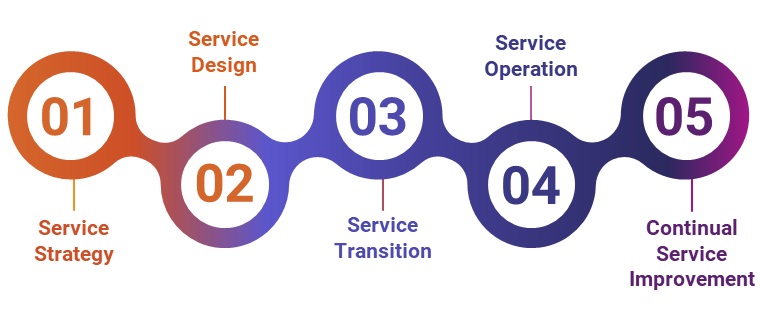
What is IT Service Management (ITSM)?
Any business environment is made up of computers, laptops, servers, switches, cables, routers, software, drives, printers, applications, drivers, firewalls, all connected in one way or another. When so many devices are connected, it also becomes easier for intruders, viruses, trojans to enter the network as well.
IT service management often referred to as ITSM — is simply how IT teams manage the end-to-end delivery of IT services to customers. This includes all the processes and activities to design, create, deliver, and support IT services.
ITSM is not just a day to day service to users of the organization, it is a larger umbrella that covers processes and tools that IT teams use to manage IT services, end to end, and covers all IT components within an organization.
Five Stages of ITSM Processes
IT Services have to be created or modified to ensure that all the users of the systems and processes do their jobs efficiently without any of the operations getting disrupted. To make this vision a reality, IT Infrastructure Library (ITIL V3, ITIL 2011) recommends ITSM processes to be implemented in the following five stages:


Stage One – Service Strategy
Service strategy is the foundational stage in the ITSM process. In this stage, a strategy for executing the different operations of ITSM processes is defined. Service strategy for any organization includes the following steps:
1. Strategy Management
In this step, market research is conducted, competitor tools, offerings are organized and the best strategy is developed for IT Services.
2. Service Portfolio Management
Based on the strategy developed, a list of services offerings is arrived at considering the budget and the customer requirements.
3. Financial Management
In this step, the budget, accounts, and bills for IT Services are managed.
4. Demand And Capacity Management
In this step, the organization’s demand for defined IT services is analyzed and equivalent resource management is done to ensure that customer demands are met.
5. Business Relationship Management
This step ensures that there is a cordial relationship between customer and IT Team, that the customer’s requirements are understood and implemented by the team.

Stage Two – Service Design
The responsibility of the service design stage is to ensure that the strategy developed in the previous stage is implemented into required IT services such that customers have a seamless experience. Service design encompasses taking care of the following elements.
1. Design Coordination
Design coordination ensures that the design process takes into consideration all IT services (new and existing), tools, technology, and metrics.
2. Service Catalogue Management
An IT Services catalogue is a listing of all the services provided by the IT team, their interdependencies, and their present status.
3. Risk Management
Risk management ensures that while designing IT processes, all the risks have been identified and addressed, including their impact on the processes.
4. Service Level Management
Having a service level agreement with the clients, ensures that both the client and service providers are in agreement.
5. Capacity Management
Capacity management ensures that the IT team has the capacity and the resources to fulfill the expected and agreed service-level targets.
6. Availability Management
Availability management ensures that the services designed are available to customers as and when required.
7. IT Service Continuity Management
Continuity management ensures that the services are designed such that the business will not come to a standstill by meeting minimum agreed service levels criteria.
8. Information Security
Services should be designed keeping data security, confidentiality and integrity of the organization.
9. Compliance
Services designed should be in compliance with the organization’s legal and procedural standards.
10. Architecture Management
Architecture management ensures that the services are planned and designed keeping in mind the future technological landscape of the organization and the advancements in the technology sector.
11. Supplier Management
Supplier management ensures that any dealings with third party vendors and contractors happen under the contractual procedures of the organization.

Stage Three – Service Transition
The next step after designing services is complete is called service transition into a test environment. In this step, while new services are test-launched, the IT team needs to ensure that the present services are not disrupted or broken.
Following steps are taken to ensure the same:
1. Change Management and Evaluation
While the new or modified services are being deployed, a change log of all the IT changes needs to be maintained, whether its operational, strategic, or tactical changes.
2. Project Management
Newly designed or modified IT services must be deployed in a planned way so that there is minimal downtime and absolutely minimal disruption.
3. Knowledge Management
An organizational wiki can be a place where all notes about transition can be stored for future historical reference.
4. Service Asset and Configuration Management
This step ensures that the various IT assets required for the new and modified services are maintained and managed and their configuration stored for reference.
5. Release and Deployment Management
This step ensures that all the new and modified services being deployed are planned thoroughly, scheduled appropriately, and various releases are deployed in a controlled environment with minimal disruption.

Stage Four – Service Operation
Once the new and modified services are deployed in test environments and it has been proven that they are functional and cause no disruption of existing services, it is time to implement them in the live environment. As these services will now be used by customers, IT teams need to closely monitor processes and workflows and be proactive in ensuring continuity in service delivery.
1. Incident And Request Fulfillment Management
This step ensures that all customer requests are attended and resolved at the earliest.
2. Problem Management
This step ensures that all IT problems are managed, their impact is minimized, the team gets to the root cause of the problem and comes up with a solution or a workaround.
3. Technical Management
This step ensures that the team manages the IT infrastructure with appropriate technical expertise and support.

Stage Five – Continual Service Improvement
Even after final deployment of new and modified IT services in the live environment and ensuring that the customers are not affected or their queries are resolved, it is still not the last stage.
The IT team must continuously monitor the performance of those services and make necessary changes to improve customer experience. Key performance indicators (KPIs) and metrics play a significant role in identifying areas that need improvement or change.
Following steps would be crucial in making that happen:
1. IT Service Review
This step ensures that the offered services and IT infrastructure are reviewed to identify any gaps and areas of improvements.
2. Process Evaluation
Process evaluation ensures that processes are monitored and quality service benchmarks are maintained.
3. CSI Initiatives Management
This step ensures that CSI activities are executed and any faults are fixed along the way by defining and monitoring CSI initiatives.






